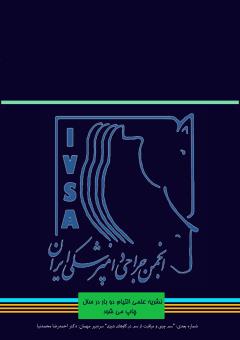Laparoscopic ovariectomy in dogs: a comparison of the Ligasure, Ultrasound, Bipolar, and Ligature methods
Subject Areas : Veterinary Soft and Hard Tissue SurgeryMohammad Yasan Bangash 1 * , Mir Sepehr Pedram 2 , Sanaz Banifazl 3 , Mohammad Molazem 4 , Maryam Iran Manesh 5 , Fariba Khaki 6 , Yazdan Aryazand 7
1 - Tehran University
2 - University of Tehran
3 - Tehran University
4 - Tehran University
5 - Tehran University
6 - Tehran University
7 - Tehran University
Keywords: Laparoscopy, Ovariectomy, Ligasure, Bipolar, Ultrasound Scalpel, Dog ,
Abstract :
Introduction: Laparoscopic ovariectomy is one of the common procedures performed in adult female dogs. The objective of this study was to compare the intraoperative and postoperative effects of laparoscopic ovariectomy with four hemostasis methods including Ligasure(LS), Ultrasound scalpel(US), Bipolar(BP) electrosurgery, and ligature(LT). Materials and Methods: 9 adult mix breed female dogs divided into four groups (LS, US, and LT(n=2); BP (n=3)). Total operation time(TT), Total hemostasis time(HT), presence of hemorrhage was recorded during surgery. In the 7th day objects euthanized to investigate abdominal cavity for gross pathologic changes such as presence of adhesion, and histopathological changes due to thermal damage in organs adjacent to anatomic region of ovaries such as uterine horns. Results: Both TT and HT significantly reduced in LS and US groups in comparison with BP group (P<0.05). TT and HT in LT group were significantly more than BP group. Minimum adhesion score were detected in LS and US groups (no significant difference) which were significantly lesser than BP group (P<0.05). In LT group granuloma around suture material were detected. Thermal damage on uterine horn were significantly higher in BP and LS groups (no significant difference) than US and LT(with no thermal injury) groups (p<0.05). Discussion and Conclusion: Application of easy, fast, safe method of hemostasis with minimal thermal damage and postoperative complications is mandatory in laparoscopic ovariectomy. Use of Ultrasonic scalpel in comparision with other methods was fast, and the most applicable with minimum thermal injury and postoperative complications in laparoscopic ovariectomy.
1. Gower S, Mayhew P. Canine laparoscopic and laparoscopic-assisted ovariohysterectomy and ovariectomy. Compend Yardley PA. 2008;30(8):430–40.
2. Zamir G, Bloom A, Reissman P. Prevention of intestinal adhesions after laparotomy in a rat model—a randomized prospective study. Res Exp Med. 1997;349–53.
3. Kalayci M, Soylu A, Eroglu H. Effect of ankaferd blood stopper on hemostasis and histopathological score in experimental liver injury. Bratisl Lek List. 2010;111(4):183–8.
4. Öhlund M, Höglund O, Olsson U, Lagerstedt A. Laparoscopic ovariectomy in dogs : a comparison of the LigaSure TM and the SonoSurg TM systems. J Small Anim Pr. 2011;52(6):290–4.
5. Fossum TW. Small Animal Surgery. Elsevier Health Sciences; 2013. pages 136-7
6. Ta A. Bipolar Vessel Sealer versus Harmonic Scalpel in Laparoscopic Supracervical Hysterectomy. Gynecol Obstet. 2012;02(05):10–3.
7. Demirturk F, Aytan H, Caliskan AC. Comparison of the use of electrothermal bipolar vessel sealer with harmonic scalpel in total laparoscopic hysterectomy. 2007;33(3):341–5.
8. Reich H. Laparoscopic Surgery for Adhesiolysis. Obgyn.net. 2011.
9. Kauko M. New techniques using the ultrasonic scalpel in laparoscopic hysterectomy. Curr Opin Obs Gynecol 1998;10(4):303–5.
10. McCarus S. Physiologic mechanism of the ultrasonically activated scalpel. J Am Assoc Gynecol Laparosc. 1996 ;3(4):601–8.
11. Dhepnorrarat RC, Witterick IJ. New technologies in thyroid cancer surgery. Oral Oncol. 2013 Jul;49(7):659–64.
12. Sutton P, Awad S, Perkins A, Lobo D. Comparison of lateral thermal spread using monopolar and bipolar diathermy, the Harmonic Scalpel and the Ligasure. Br J Surg. 2010;97:428–33.

